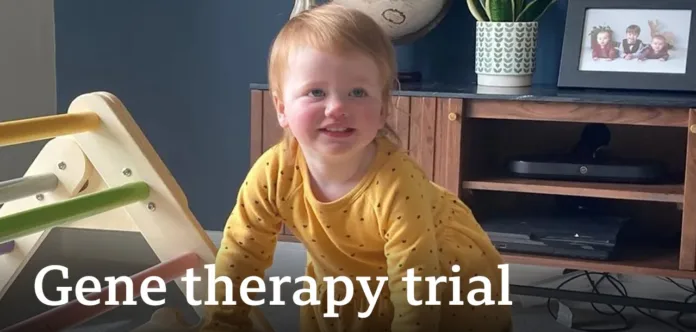Gene therapy enables Opal Sandy, the youngest patient to receive the treatment, to hear for the first time despite a rare genetic condition
A baby girl, born deaf due to a rare genetic condition called auditory neuropathy, can hear for the first time after receiving innovative gene therapy at Addenbrooke’s Hospital in Cambridge. Eleven-month-old Opal Sandy, now 18 months old, responded to sound within four weeks of receiving the therapy in her right ear. Her hearing has continued to improve over time, and she can now recognize soft sounds and words like “Dada” and “bye-bye.”
Opal was the first patient globally in the CHORD gene therapy trial. Her auditory neuropathy, caused by mutations in the OTOF gene, prevented nerve impulses from travelling from the inner ear to the brain. The CHORD trial used an infusion of a harmless virus to deliver a functional copy of the gene directly into the cochlea, which allowed her inner ear cells to communicate with the hearing nerve.
The researchers noted continuous improvement in Opal’s hearing after treatment and confirmed near-normal hearing levels at 24 weeks. Her father, James Sandy, expressed his joy at seeing Opal respond to speech sounds unaided, calling the experience “mind-blowing.”
Professor Manohar Bance, the trial’s chief investigator, stated that these results exceed expectations, marking a significant milestone in otology and audiology. The treatment signifies the potential of gene therapy as a future alternative for patients with auditory neuropathy.
Historically, children with OTOF-related hearing loss passed newborn screenings due to functioning hair cells. However, these cells failed to communicate with the nerve, often delaying detection of hearing loss until age 2 or 3. The new therapy could drastically change this timeline, providing earlier interventions and reducing the impact on a child’s development.
While gene therapy does not currently replace cochlear implants, it could become a less invasive treatment that requires minimal follow-up, according to Dr Richard Brown, a consultant paediatrician and investigator in the CHORD trial. He emphasized the importance of genomic medicine and the potential to offer hope for children worldwide.
The research, sponsored by Regeneron, has enrolled patients in the UK, the US, and Spain. The study involves a three-phase approach to determine the optimal dosage and safety for children. Opal’s initial results and data from other participants will be presented at the American Society of Gene and Cell Therapy in Baltimore.
Martin McLean, Senior Policy Advisor at the National Deaf Children’s Society, applauds these developments but emphasizes that deaf children can still live fulfilling lives with appropriate support. The organization encourages families to make informed decisions about medical technologies to ensure the best outcomes for their children.
The trial’s success could signal the beginning of a new era for genetic therapies, potentially addressing other genetic hearing conditions and providing valuable insights into overcoming previously incurable disorders.
Analysis:
The breakthrough success of Opal Sandy’s treatment through the CHORD trial illuminates the possibilities of gene therapy in transforming medical care, particularly for conditions like auditory neuropathy. This pioneering intervention is a beacon of hope for families grappling with congenital deafness.
From a sociological standpoint, the ability of this treatment to intervene early in the development of deaf children could help reduce stigma and empower families. Early intervention is crucial in supporting a child’s cognitive, social, and emotional development, fostering inclusive environments where differences in hearing are embraced rather than seen as barriers.
Economically, gene therapy promises to be a cost-effective alternative to current treatments. Although the upfront costs may be significant, reduced follow-up appointments and a potential decrease in reliance on cochlear implants could alleviate the long-term financial burden on families and healthcare systems.
Politically, the CHORD trial highlights the importance of investing in genomic research and innovative healthcare solutions. Governments and healthcare organizations will need to assess how they can integrate gene therapy into national health systems, ensuring accessibility and equitable distribution across socioeconomic backgrounds.
Ethically, the success of Opal’s treatment raises questions about informed consent and the implications of manipulating genetic material. While the therapy provides profound benefits, families should be educated about potential risks and supported in making informed decisions.
Gender perspectives should also be considered, as mothers often bear the brunt of caregiving and navigating the complexities of medical interventions. Opal’s success could empower women to advocate for their children’s health and strengthen the family unit as they navigate this new frontier together.
In conclusion, Opal Sandy’s successful treatment exemplifies a leap forward in genomic medicine. By demonstrating the feasibility of addressing specific genetic conditions, the CHORD trial’s outcomes have the potential to reshape hearing care and unlock new possibilities in genetic therapy.
